Managing Free-Range Laying Hens—Part A: Frequent and Non-Frequent Range Users Differ in Laying Performance but Not Egg Quality
Abstract
Simple Summary
Abstract
1. Introduction
2. Materials and Methods
2.1. Ethical Statement
2.2. Animal Housing and Management
2.3. Range Use Monitoring
2.4. Range Use Sub-Populations
2.5. Egg Performance and Egg Quality
2.6. Statistical Analyses
3. Results
3.1. Range Use Differences of Sub-Population over Time
3.1.1. Daily Mean Duration on the Range
3.1.2. Percentage of Days on the Range
3.2. Range Use Variation
3.3. Bodyweight Differences of Flock Sub-Populations
3.4. Laying Performance and Egg Quality of Flock Sub-Populations
3.5. Egg Quality Differences of Flock Sub-Populations
3.6. The Comparison of the Percentage of System, Floor and Waste Eggs
3.7. The Comparison of Flock Sub-Populations on Egg Grading
4. Discussion
5. Conclusions
Author Contributions
Funding
Acknowledgments
Conflicts of Interest
References
- Wolc, A.; Arango, J.; Settar, P.; O’Sullivan, N.P.; Dekkers, J.C. Evaluation of egg production in layers using random regression models. Poult. Sci. 2011, 90, 30–34. [Google Scholar] [CrossRef]
- Aerni, V.; Rinkhof, M.W.G.; Wechsler, B.; Oester, H.; Frohlich, E. Productivity and mortality of laying hens in aviaries: A systematic review. World Poult. Sci. J. 2005, 61, 130–142. [Google Scholar] [CrossRef]
- Van Horne, P.L.M. Production and economic results of commercial flocks with white layers in aviary systems and battery cages. Br. Poult. Sci. 1996, 37, 55–61. [Google Scholar] [CrossRef] [PubMed]
- Singh, M.; Cowieson, A.J. Range use and pasture consumption in free-range poultry production. Anim. Prod. 2013, 53, 1202–1208. [Google Scholar] [CrossRef]
- Rodenburg, T.B.; Tuyttens, F.A.; Sonck, B.; De Reu, K.; Herman, L.; Zoons, J. Welfare, health, and hygiene of laying hens housed in furnished cages and in alternative housing systems. J. Appl. Anim. Welf. Sci. 2005, 8, 211–226. [Google Scholar] [CrossRef] [PubMed]
- Lay, D.C.; Fulton, R.M.; Hester, P.Y.; Karcher, D.M.; Kjaer, J.B.; Mench, J.A.; Mullens, B.A.; Newberry, R.C.; Nicol, C.J.; O’Sullivan, N.P.; et al. Hen welfare in different housing systems. Poult. Sci. 2011, 90, 278–294. [Google Scholar] [CrossRef] [PubMed]
- Freire, R.; Cowling, A. The welfare of laying hens in conventional cages and alternative systems: First steps towards a quantitative comparison. Anim. Welf. 2013, 22, 57–65. [Google Scholar] [CrossRef]
- Gebhardt-Henrich, S.G.; Toscano, M.J.; Frohlich, E.K.F. Use of outdoor ranges by laying hens in different sized flocks. Appl. Anim. Behav. Sci. 2014, 155, 74–81. [Google Scholar] [CrossRef]
- Gebhardt-Henrich, S.; Fröhlich, E.; Burose, F.; Fleurent, J.; Gantner, M.; Zähner, M. Individual tracking of laying hens with an RFID-System. Landtechnik 2014, 69, 301–306. [Google Scholar]
- Gilani, A.M.; Knowles, T.G.; Nicol, C.J. Factors affecting ranging behaviour in young and adult laying hens. Br. Poult. Sci. 2014, 55, 127–135. [Google Scholar] [CrossRef]
- Fanatico, Alternative Poultry Production Systems and Outdoor Access. 2006. A Publication of ATTRA- National Sustainable Agriculture Information Service, 1-800-346-9140. Available online: www.attra.ncat.org (accessed on 3 June 2020).
- Sibanda, T.Z.; Walkden-Brown, S.W.; Kolakshyapati, M.; Dawson, B.; Schneider, D.; Welch, M.; Iqbal, Z.; Cohen-Barnhouse, A.; Morgan, N.K.; Boshoff, J.; et al. Flock use of the range is associated with the use of different components of a multi-tier aviary system in commercial free-range laying hens. Br. Poult. Sci. 2019, 61, 97–106. [Google Scholar] [CrossRef] [PubMed]
- Coletta, L.D.; Pereira, A.L.; Coelho, A.A.D.; Savino, V.J.M.; Menten, J.F.M.; Correr, E.; Franca, L.C.; Martinelli, L.A. Barn vs. free-range chickens: Differences in their diets determined by stable isotopes. Food Chem. 2012, 131, 155–160. [Google Scholar] [CrossRef]
- Abbas, S.A.; Elseid, A.G.; Ahmed, M.K.A. Effect of body weight uniformity on the productivity of broiler breeder hens. Int. J. Poult. Sci. 2010, 9, 225–230. [Google Scholar]
- Suawa, E.K.; Roberts, J.R.; Parkinson, G. Bodyweight uniformity and eggshell quality of hens in a free-range production system. In Proceedings of the Australian Poultry Science Symposium, Sydney, Australia, 15–17 February 2016. [Google Scholar]
- Campbell, D.; Makagon, M.; Swanson, J.; Siegford, J. Perch use by laying hens in a commercial aviary. Poult. Sci. 2016, 95, 1736–1742. [Google Scholar] [CrossRef] [PubMed]
- Gocsik, É.; Saatkamp, H.W.; de Lauwere, C.C.; Lansink, A.G.J.M. A Conceptual Approach for a Quantitative Economic Analysis of Farmers’ Decision-Making Regarding Animal Welfare. J. Agric. Environ. Ethics 2014, 27, 287–308. [Google Scholar] [CrossRef]
- Sibanda, T.Z.; Dawson, B.; Welch, M.; Schneider, D.; Boshoff, J.; Kolakshyapati, M.; Ruhnke, I. Validation of a Radio Frequency Identification (RFID) system for aviary systems. In Proceedings of the 31th Australian Poultry Science Symposium, Sydney, Australia, 16–19 February 2020. [Google Scholar]
- Tumova, E.; Ebeid, T. Effect of housing system on performance and egg quality characteristics in laying hens. Sci. Agric. Bohem. 2003, 34, 73–80. [Google Scholar]
- Englmaierova, M.; Tumova, E.; Charvatova, V.; Skrivan, M. Effects of laying hens housing system on laying performance, egg quality characteristics, and egg microbial contamination. Czech J. Anim. Sci. 2014, 59, 345–352. [Google Scholar] [CrossRef]
- Lordelo, M.; Fernandes, E.; Bessa, R.J.B.; Alves, S.P. Quality of eggs from different laying hen production systems, from indigenous breeds and specialty eggs. Poult. Sci. 2016, 96, 1485–1491. [Google Scholar] [CrossRef]
- Icken, W.; Cavero, D.; Schmutz, M.; Thurner, S.; Wendl, G.; Preisinger, R. Analysis of the free range behaviour of laying hens and the genetic and phenotypic relationships with laying performance. Br. Poult. Sci. 2008, 49, 533–541. [Google Scholar] [CrossRef]
- Hegelund, L.; Sorensen, J.T.; Hermansen, J.E. Welfare and productivity of laying hens in commercial organic egg production systems in Denmark. NJAS Wagening. J. Life Sci. 2006, 54, 147–155. [Google Scholar] [CrossRef]
- D’Eath, R.B.; Keeling, L.J. Social discrimination and aggression by laying hens in large groups: From peck orders to social tolerance. Appl. Anim. Behav. Sci. 2003, 84, 197–212. [Google Scholar] [CrossRef]
- Kolakshyapati, M.; Taylor, P.S.; Sibanda, T.Z.; Ruhnke, I. Association of fearfulness at the end of lay with range visits during 18-22 weeks of age in commercial laying hens. In Proceedings of the Congress of the International Society for Applied Ethology, Bergen, Norway, 5–9 August 2019. [Google Scholar]
- Campbell, D.L.; Hinch, G.N.; Downing, J.A.; Lee, C. Fear and coping styles of outdoor-preferring, moderate-outdoor and indoor-preferring free-range laying hens. Appl. Anim. Behav. Sci. 2016, 185, 73–77. [Google Scholar] [CrossRef]
- Hartcher, K.; Hickey, K.; Hemsworth, P.; Cronin, G.; Wilkinson, S.; Singh, M. Relationships between range access as monitored by radio frequency identification technology, fearfulness, and plumage damage in free-range laying hens. Animal 2016, 10, 847–853. [Google Scholar] [CrossRef] [PubMed]
- Lohmann Brown Classic Management Guide, 2019: Management Guide: Alternative Systems [PDF file]. Available online: https://www.ltz.de/de-wAssets/docs/management-guides/en/Non-Cage/LTZ_MG_AlternHaltung_EN.pdf (accessed on 7 February 2020).
- Godfrey, G.F.; Williams, C.; Marshall, C.E. The relative influence of egg size, age at sexual maturity and mature body weight on growth to twelve weeks of age. Poult. Sci. 1953, 32, 496–500. [Google Scholar] [CrossRef]
- Lewis, P.D.; Gous, R.M. Responses of poultry to ultraviolet radiation. Worlds Poult. Sci. J. 2009, 65, 499–510. [Google Scholar] [CrossRef]
- Siopes, T.D.; Wilson, W.O. Participation of the eyes in the photo-stimulation of chickens. Poult. Sci. 1980, 59, 1122–1125. [Google Scholar] [CrossRef] [PubMed]
- Iqbal, Z.; Roberts, J.; Perez-Maldonado, R.A.; Goodarzi Boroojeni, F.; Swick, R.A.; Ruhnke, I. Pasture, multi-enzymes, benzoic acid and essential oils positively influence performance, intestinal organ weight and egg quality in free-range laying hens. Br. Poult. Sci. 2018, 59, 180–189. [Google Scholar] [CrossRef]
- Svihus, S.; Sacranie, A.; Denstadli, V.; Choct, M. Nutrient utilization and functionality of the anterior digestive tract due to intermittent feeding and whole wheat inclusion in diets for broiler chickens. Poult. Sci. 2010, 89, 2617–2625. [Google Scholar] [CrossRef]
- Svihus, B. Function of the digestive system. J. Appl. Poult. Res. 2014, 23, 306–314. [Google Scholar] [CrossRef]
- Lietzow, J.; Kluge, H.; Brandsch, C.; Seeburg, N.; Hirche, F.; Glomb, M.; Stangl, J.I. Effect of Short-Term UVB exposure on vitamin D concentration of eggs and vitamin D status of laying hens. J. Agric. Food Chem. 2012, 60, 799–804. [Google Scholar] [CrossRef]
- Wei, Y.; Zheng, W.; Li, B.; Tong, Q.; Shi, H.; Li, X. Effects of B-Wave Ultraviolet Supplementation Using Light-Emitting Diodes on Caged Laying Hens during the Later Phase of the Laying Cycle. Animals 2020, 10, 15. [Google Scholar] [CrossRef] [PubMed]
- Liu, K.; Xin, H.; Sekhon, J.; Wang, T. Effect of fluorescent vs. poultry-specific light-emitting diode lights on production performance and egg quality of W-36 laying hens. Poult. Sci. 2018, 97, 834–844. [Google Scholar] [CrossRef] [PubMed]
- Bain, M.M.; Nys, Y.; Dunn, I.C. Increasing persistency in lay and stabilising egg quality in longer laying cycles. What are the challenges? Br. Poult. Sci. 2016, 57, 330–338. [Google Scholar] [CrossRef] [PubMed]
- Kolakshyapati, M.; Wu, S.B.; Sibanda, T.Z.; Cuevas, S.R.; Ruhnke, I. Body weight and range usage affect net energy utilisation in commercial free-range laying hens when evaluated in net energy chambers. Anim. Nutr. 2020, 6, 192–197. [Google Scholar] [CrossRef]
- Ahammed, M.; Chae, B.J.; Lohakare, J.; Keohavong, B.; Lee, M.H.; Lee, S.J.; Kim, D.M.; Lee, J.Y.; Ohh, S.J. Comparison of Aviary, Barn and Conventional Cage Raising of Chickens on Laying Performance and Egg Quality. Asian-Australas. J. Anim Sci. 2014, 27, 1196–1203. [Google Scholar] [CrossRef] [PubMed]
- Ferrante, V.; Lolli, S.; Vezzoli, G.; Cavalchini, L.G. Effects of two different rearing systems (organic and barn) on production performance, animal welfare traits and egg quality characteristics in laying hens. Ital. J. Anim. Sci. 2009, 2, 165–174. [Google Scholar] [CrossRef]
- Palvlovski, Z.; Hopic, S.; Lukic, M. Housing systems for layers and egg quality. Biotech. Anim. Husb. 2001, 17, 197–201. [Google Scholar]
- Golden, J.B.; Arbona, D.V.; Anderson, K.E. A comparative examination of rearing parameters and layer production performance for brown egg-type pullets grown for either free-range or cage production. J. Appl. Poult. Res. 2012, 21, 92–102. [Google Scholar] [CrossRef]
- Thuy, D.A.; Larsen, H.; Rault, J.L. Behavioural repertoire of free-range laying hens indoors and outdoors, and in relation to distance from the shed. Aust. Vet. J. 2018, 96, 99–100. [Google Scholar]
- Silversides, F.G.; Budgell, K. The relationships among measures of egg albumen height, pH, and whipping volume. Poult. Sci. 2004, 83, 1619–1623. [Google Scholar] [CrossRef]
- Roberts, J.R. Factors affecting egg internal quality and eggshell quality in laying hens. J. Poult. Sci. 2004, 41, 161–177. [Google Scholar] [CrossRef]
- Matthews, W.; Sumner, D. Effects of housing system on the costs of commercial egg production. Poult. Sci. 2014, 94, 552–557. [Google Scholar] [CrossRef] [PubMed]
- Van Den Brand, H.; Parmentier, H.K.; Kemp, B. Effects of housing system (outdoor vs cages) and age of laying hens on egg characteristics. Br. Poult. Sci. 2004, 45, 745–752. [Google Scholar] [CrossRef] [PubMed]
- Michel, V.; Huonnic, D. A comparison of welfare, health and production performance of laying hens reared in cages or aviaries. Br. Poult. Sci. 2003, 44, 775–776. [Google Scholar] [CrossRef]
- Jones, D.R.; Cox, N.A.; Guard, J.; Fedorka-Cray, P.J.; Buhr, R.J.; Gast, R.K.; Abdo, Z.; Rigsby, L.L.; Plumblee, J.R.; Karcher, D.M.; et al. Microbiological impact of three commercial laying hen housing systems. Poult. Sci. 2015, 94, 544–551. [Google Scholar] [CrossRef]
- Villanueva, S.; Ali, A.B.; Campbell, D.L.; Siegford, J.M. Nest use and patterns of egg-laying and damage by 4 strains of laying hens in an aviary system. Poult. Sci. 2017, 96, 3011–3020. [Google Scholar] [CrossRef]
- Channing, C.E.; Hughes, B.O.; Walker, A.W. Spatial distribution and behaviour of laying hens housed in an alternative system. Appl. Anim. Behav. Sci. 2001, 72, 335–345. [Google Scholar] [CrossRef]
- Smith, S.F.; Appleby, M.C.; Hughes, B.O. Problem-solving by hens: Opening doors to reach nest sites. Appl. Anim. Behav. Sci. 1990, 28, 287–292. [Google Scholar] [CrossRef]
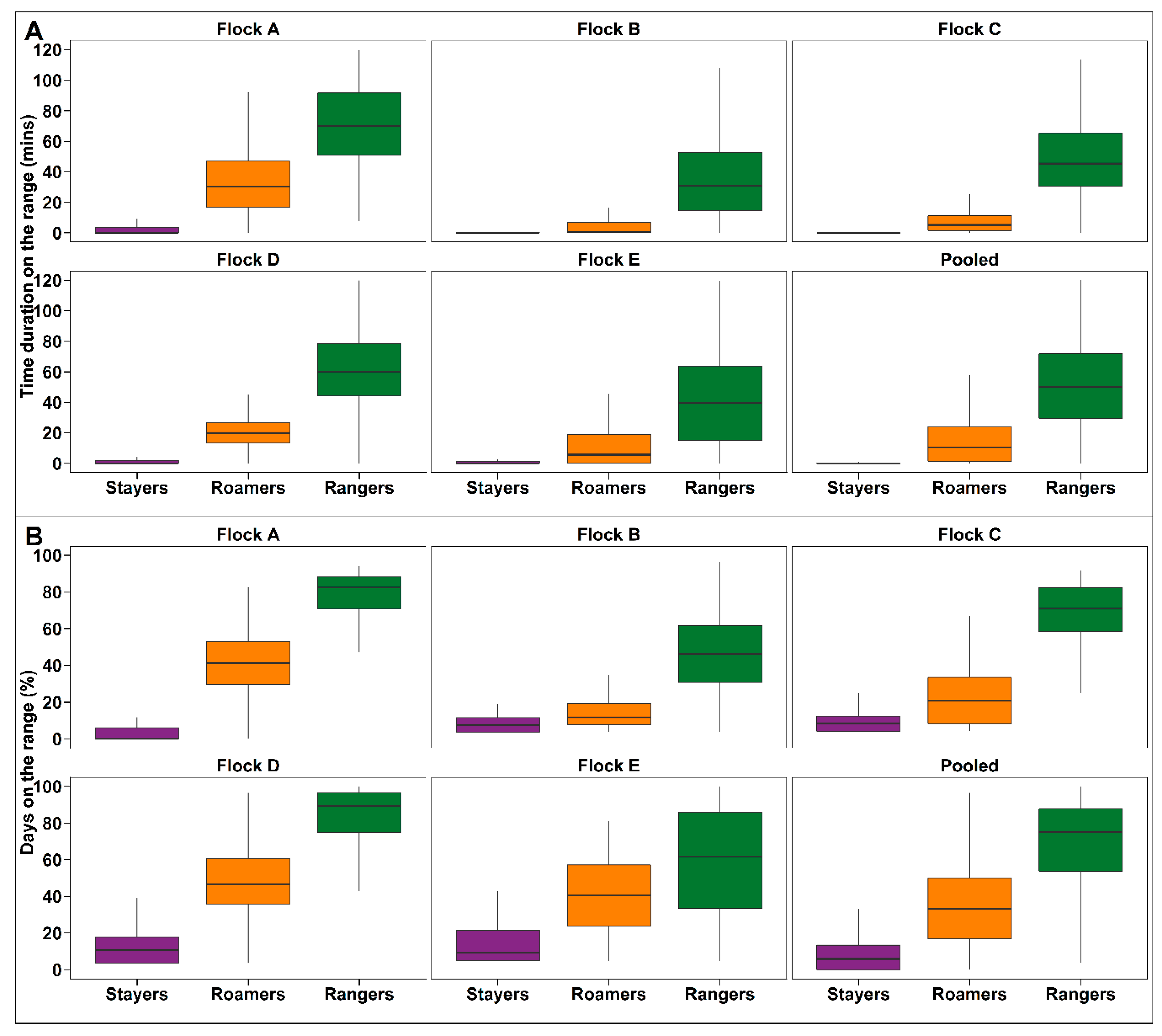
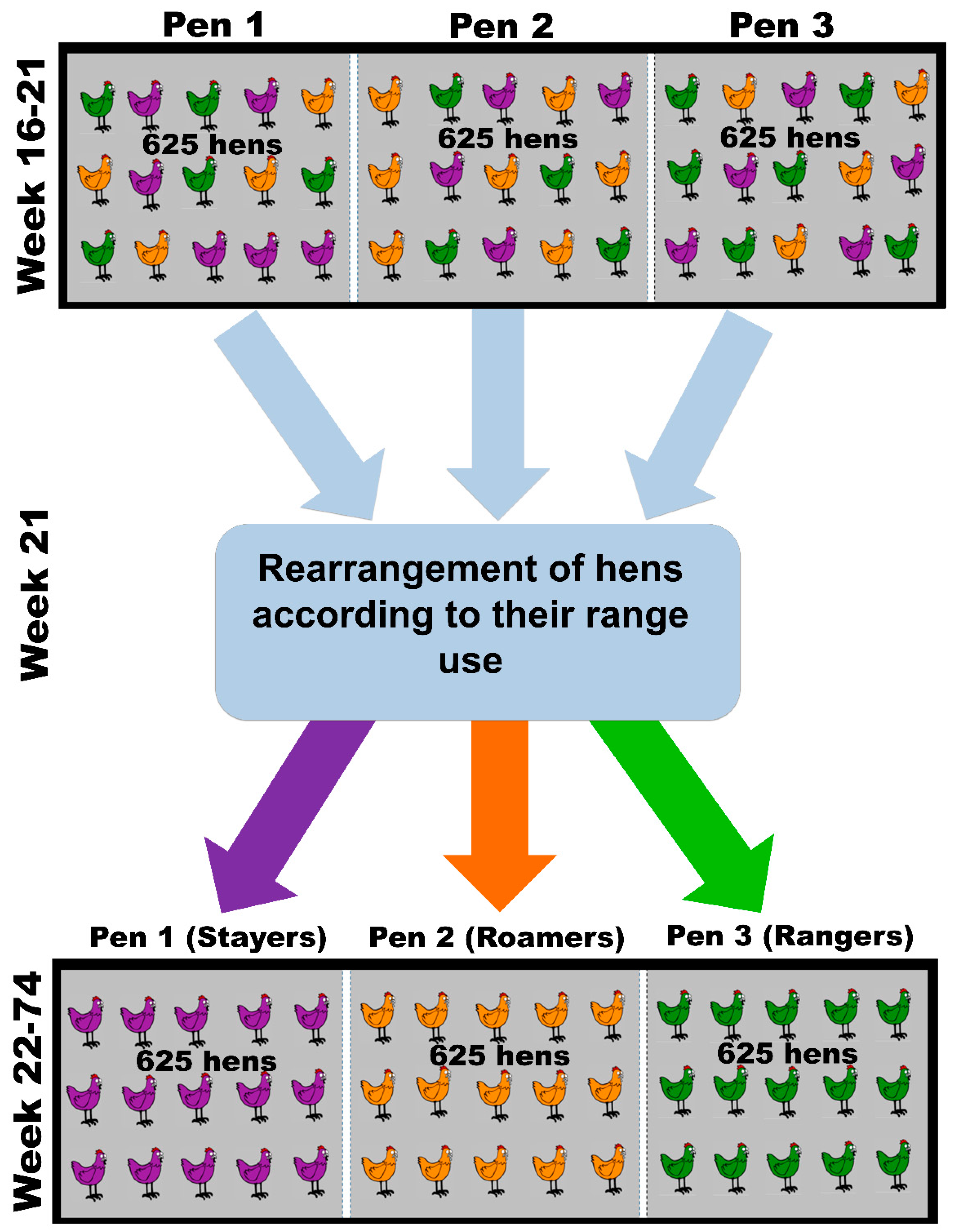
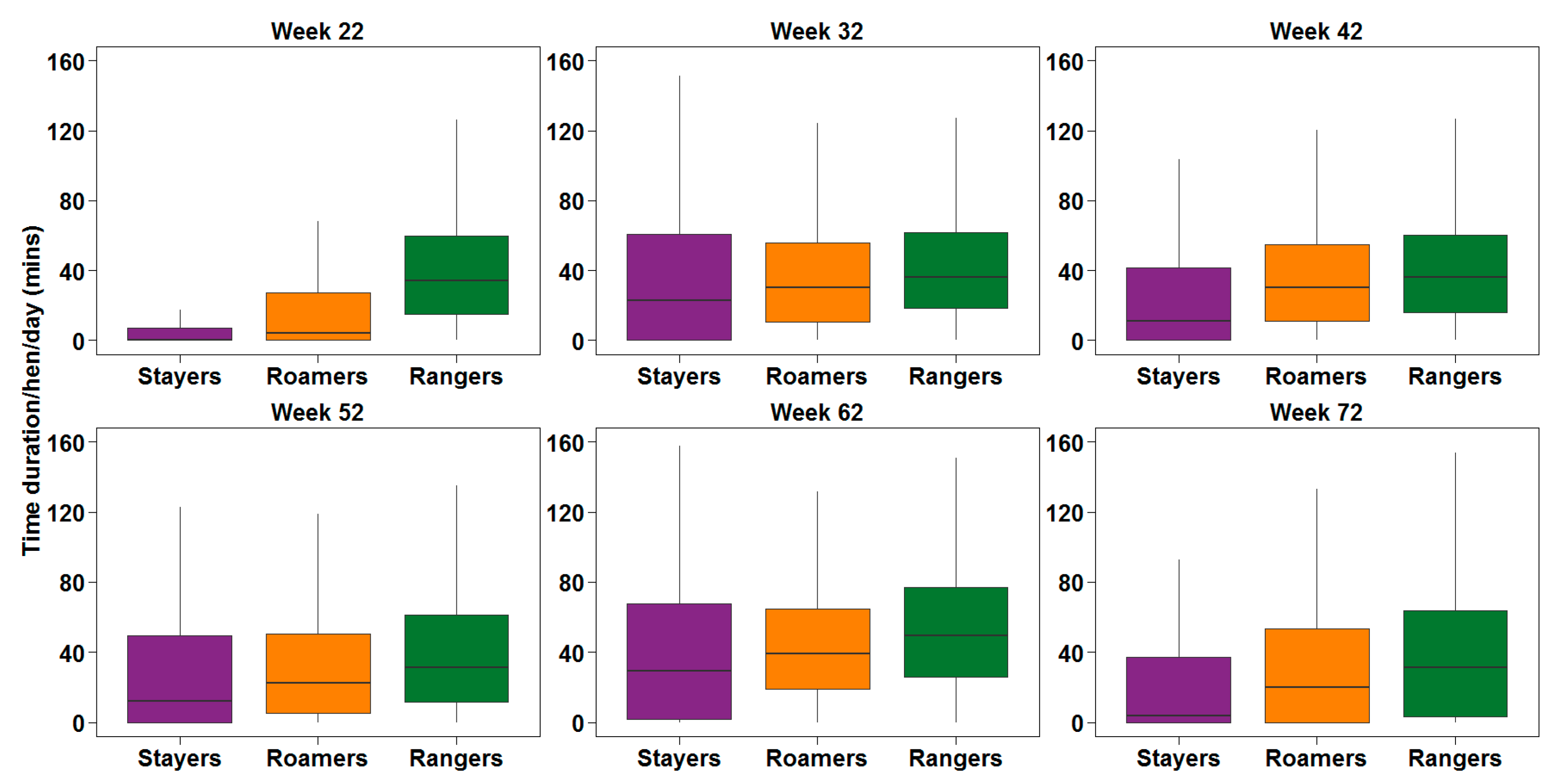
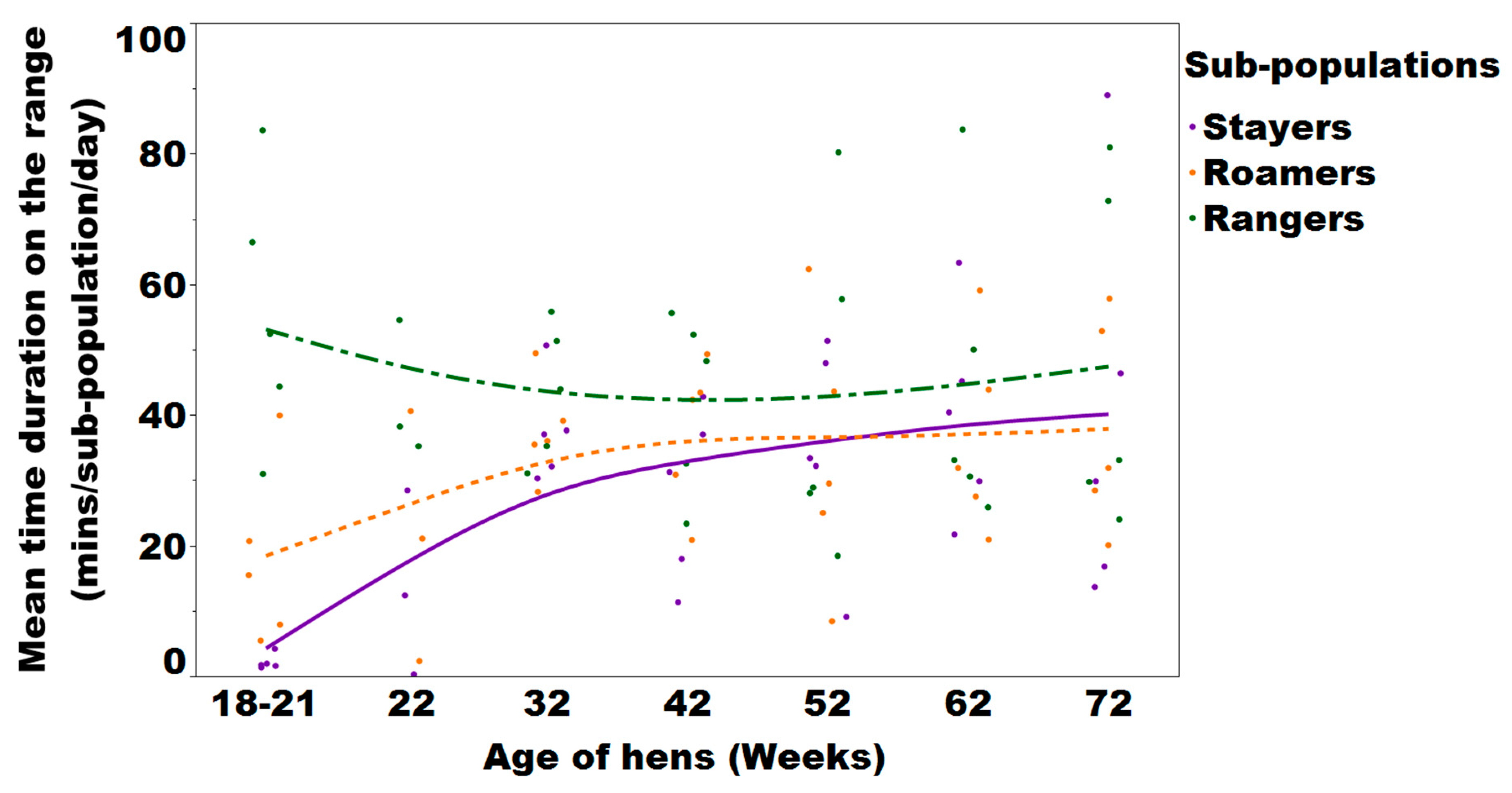
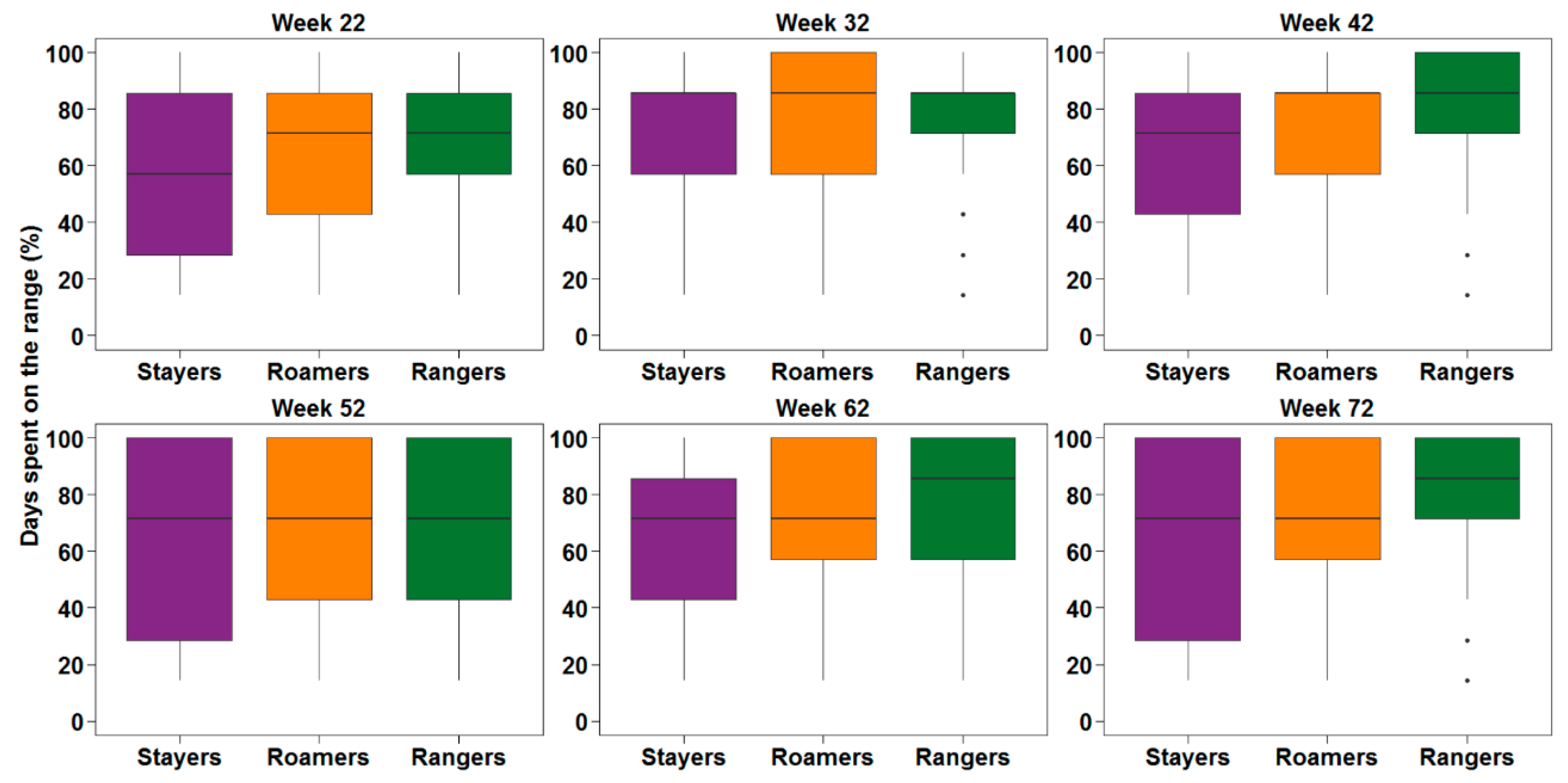

| Age of Hens (Weeks) | Stayers | Roamers | Rangers | |
|---|---|---|---|---|
| Bodyweight (kg) | 16 | 1.29 ± 0.021 h | 1.30 ± 0.022 g | 1.33 ± 0.021 f |
| 22 | 1.68 ± 0.012 e | 1.74 ± 0.008 d | 1.78 ± 0.010 c | |
| 74 | 1.86 ± 0.020 b | 1.88 ± 0.031 a | 1.89 ± 0.027 a | |
| p-value Sub-population | 0.0001 | |||
| p-value Age of hens | 0.0001 | |||
| p-value Sub-population × Age | 0.0001 | |||
| Laying performance (%) | 22 | 78.2 ± 1.9 Cb | 83.9 ± 1.6 Bab | 88.0 ± 1.1 ABa |
| 32 | 93.5 ± 1.1 Aa | 86.1 ± 1.5 Bb | 91.6 ± 1.0 Aab | |
| 42 | 90.8 ± 2.3 ABa | 91.7 ± 0.8 ABa | 93.9 ± 0.7 Aa | |
| 52 | 87.1 ± 1.8 Ba | 83.8 ± 2.3 Ba | 87.3 ± 1.9 ABa | |
| 62 | 89.7 ± 3.0 ABa | 94.6 ± 1.3 Aa | 85.2 ± 1.5 Bb | |
| 72 | 95.5 ± 0.9 Aa | 89.9 ± 1.4 ABab | 85.1 ± 0.9 Bb | |
| p-value Sub-population | 0.3634 | |||
| p-value Age of hens | 0.0001 | |||
| p-value Sub-population × Age | 0.0001 | |||
| Age of Hens (Weeks) | 22 | 32 | 42 | 52 | 62 | 72 | |
|---|---|---|---|---|---|---|---|
| Albumen height (mm) | Stayers | 7.48 ± 0.12 Aa | 7.20 ± 0.13 Aa | 7.17 ± 0.20 Aab | 5.83 ± 0.17 Bb | 6.30 ± 0.21 Ab | 5.8 ± 0.33 Ab |
| Roamers | 7.47 ± 0.12 Aa | 7.36 ± 0.21 Aab | 6.49 ± 0.16 Aab | 5.61 ± 0.23 Bb | 5.75 ± 0.18 Ab | 5.36 ± 0.24 Ab | |
| Rangers | 7.76 ± 0.18 Aa | 7.32 ± 0.14 Aab | 6.70 ± 0.17 Aab | 7.40 ± 1.53 Aab | 5.41 ± 0.17 Ab | 5.56 ± 0.25 Ab | |
| p-value Sub-population | 0.128 | ||||||
| p-value Age of hen | 0.001 | ||||||
| p-value Sub-population × Age | 0.017 | ||||||
| Egg weight (g) | Stayers | 51.3 ± 0.40 Ab | 70.7 ± 7.64 Aa | 64.3 ± 0.47 Aa | 62.0 ± 0.61 Aa | 61.8 ± 0.50 Aa | 64.6 ± 1.05 Aa |
| Roamers | 51.5 ± 0.44 Ab | 57.1 ± 0.62 Aab | 63.3 ± 0.54 Aab | 62.0 ± 0.74 Aab | 69.8 ± 8.23 Aa | 62.4 ± 0.67 Aab | |
| Rangers | 51.7 ± 0.36 Aa | 60.5 ± 0.54 Aa | 63.9 ± 0.67 Aa | 61.6 ± 0.63 Aa | 62.0 ± 0.64 Aa | 61.4 ± 0.93 Aa | |
| p-value Sub-population | 0.5189 | ||||||
| p-value Age of hen | 0.0001 | ||||||
| p-value Sub-population × Age | 0.1246 | ||||||
| Yolk colour | Stayers | 11.6 ± 0.10 Aab | 11.3 ± 0.17 Ac | 11.5 ± 0.11A a | 11.9 ± 0.16 Aa | 10.9 ± 0.18 Acd | 10.6 ± 0.11 Ad |
| Roamers | 11.5 ± 0.11 Ab | 11.8 ± 0.17 Aa | 11.6 ± 0.12 Ab | 11.9 ± 0.17 Aa | 10.8 ± 0.18 Ac | 10.2 ± 0.22 Ad | |
| Rangers | 11.4 ± 0.11 Ab | 11.8 ± 0.19 Ab | 11.5 ± 0.11Ab | 12.3 ± 0.18 Aa | 10.9 ± 0.17 Ad | 10.6 ± 0.11 Ad | |
| p-value Sub-population | 0.4178 | ||||||
| p-value Age of hen | 0.0001 | ||||||
| p-value Sub-population × Age | 0.0939 | ||||||
| Haugh unit | Stayers | 88.6 ± 0.62 Aa | 84.4 ± 0.77 Aab | 82.2 ± 1.36 Ab | 78.7 ± 0.97 Abc | 76.9 ± 1.44 Abc | 71.9 ± 2.42 Ac |
| Roamers | 88.4 ± 0.70 Aa | 85.9 ± 0.97 aA | 79.6 ± 1.20 Ac | 73.7 ± 2.43 Ade | 73.1 ± 1.24 Ad | 69.9 ± 1.92 Ae | |
| Rangers | 89.5 ± 0.85 Aa | 85 ± 0.84 abA | 79.9 ± 1.27 Ab | 77 ± 1.71 Abc | 72.1 ± 1.21 Ac | 71.6 ± 1.88 Ac | |
| p-value Sub-population | 0.024 | ||||||
| p-value Age of hen | 0.0001 | ||||||
| p-value Sub-population × Age | 0.1013 | ||||||
| Egg shell breaking strength (N) | Stayers | 4.53 ± 0.48 Aa | 4.54 ± 0.14 Aa | 4.9 ± 0.15 Ba | 4.62 ± 0.13 Aa | 4.12 ± 0.10 Aa | 4.11 ± 0.21 Aa |
| Roamers | 4.18 ± 0.13 Ab | 4.95 ± 0.76 Aab | 6.47 ± 1.05 Aa | 5.28 ± 0.63 Aab | 4.05 ± 0.15 Ab | 3.76 ± 0.19 Aab | |
| Rangers | 4.42 ± 0.12 Aa | 4.24 ± 0.16 Aa | 4.38 ± 0.15 Ba | 4.5 ± 0.16 Aa | 4.51 ± 0.12 Aa | 3.81 ± 0.18 Aa | |
| p-value Sub-population | 0.1995 | ||||||
| p-value Age of hen | 0.0099 | ||||||
| p-value Sub-population × Age | 0.122 | ||||||
| Age of Hens (Weeks) | 22 | 32 | 42 | 52 | 62 | 72 | |
|---|---|---|---|---|---|---|---|
| System eggs (%) | Stayers | 3.24 ± 0.37 Aa | 2.20 ± 0.26 Ab | 1.31 ± 0.30 Abc | 1.13 ± 0.16 Ac | 0.58 ± 0.13 Ac | 0.29 ± 0.07 Ad |
| Roamers | 3.11 ± 0.30 Aa | 1.58 ± 0.17 Bb | 0.91 ± 0.19 Bbc | 0.87 ± 0.12 ABbc | 0.60 ± 0.13 Ac | 0.55 ± 0.13 Ac | |
| Rangers | 2.77 ± 0.21 Aa | 1.18 ± 0.13 Bb | 0.55 ± 0.11 Bbc | 0.67 ± 0.09 Bbc | 0.63 ± 0.09 Abc | 0.45 ± 0.09 Ac | |
| p-value Sub-population | 0.0001 | ||||||
| p-value Age of hen | 0.0001 | ||||||
| p-values Sub-population × Age | 0.0177 | ||||||
| Floor eggs (%) | Stayers | 0.43 ± 0.08 Aa | 0.34 ± 0.06 Aa | 0.30 ± 0.09 Aa | 0.38 ± 0.06 Aa | 0.54 ± 0.14 Aa | 0.36 ± 0.05 Aa |
| Roamers | 0.54 ± 0.10 Aa | 0.61 ± 0.08 Aa | 0.55 ± 0.08 Aa | 0.43 ± 0.07 Aa | 0.43 ± 0.11 Aa | 0.46 ± 0.08 Aa | |
| Rangers | 0.40 ± 0.06 Aa | 0.40 ± 0.07 Aa | 0.41 ± 0.06 Aa | 0.42 ± 0.09 Aa | 0.33 ± 0.04 Aa | 0.48 ± 0.07 Aa | |
| p-value Sub-population | 0.0148 | ||||||
| p-value Age of hen | 0.5796 | ||||||
| p-value Sub-population × Age | 0.3987 | ||||||
| Waste eggs (%) | Stayers | 0.07 ± 0.04 Aa | 0.14 ± 0.04 Aa | 0.05 ± 0.03 Aa | 0.32 ± 0.09 Aa | 0.32 ± 0.13 Aa | 0.35 ± 0.07 Aa |
| Roamers | 0.29 ± 0.10 Aa | 0.07 ± 0.02 Ab | 0.11 ± 0.05 Ab | 0.21 ± 0.06 Ab | 0.21 ± 0.06 Ab | 0.57 ± 0.07 Aa | |
| Rangers | 0.09 ± 0.04 Ab | 0.11 ± 0.04 Ab | 0.05 ± 0.02 Ab | 0.11 ± 0.04 Ab | 0.22 ± 0.04 Ab | 0.50 ± 0.09 Aa | |
| p-value Sub-population | 0.2049 | ||||||
| p-value Age of hen | 0.0001 | ||||||
| p-value Sub-population × Age | 0.0354 | ||||||
| Age of Hens (Weeks) | 22 | 32 | 42 | 52 | 62 | 72 | |
|---|---|---|---|---|---|---|---|
| Jumbo eggs [66.7–78 g] (%) | Stayers | 1.94 ± 0.14 Ac | 19.7 ± 3.68 Aa | 8.16 ± 0.93 Abc | 9.44 ± 0.78 Abc | 11.4 ± 0.52 Ab | 13.7 ± 0.66 Aab |
| Roamers | 1.98 ± 0.13 Ac | 21.4 ± 3.59 Aa | 8.31 ± 1.01 Acd | 9.17 ± 1.16 Acd | 10.4 ± 0.68 Ac | 11.5 ± 0.42 Ac | |
| Rangers | 2.30 ± 0.16 Ac | 21.7 ± 3.65 Aa | 7.03 ± 0.70 Abc | 8.80 ± 0.99 Abc | 8.50 ± 0.60 Abc | 11.5 ± 0.47 Ab | |
| p-value Sub-population | 0.6396 | ||||||
| p-value Age of hen | 0.0001 | ||||||
| p-value Sub-population × Age | 0.9609 | ||||||
| X-large eggs [58.3–66.6 g] (%) | Stayers | 4.16 ± 1.33 Ad | 48.1 ± 3.16 Ac | 69.7 ± 0.67 Aa | 65.3 ± 1.60 Aab | 65.5 ± 1.15 Aab | 60.4 ± 1.13 Ab |
| Roamers | 2.94 ± 0.21 Ad | 46.3 ± 3.31 Ac | 70.5 ± 1.03 Aa | 61.1 ± 1.89 Aab | 66.6 ± 0.83 Aab | 59.9 ± 1.23 Ab | |
| Rangers | 3.27 ± 0.21 Ad | 45.7 ± 2.75 Ac | 70.7 ± 1.08 Aa | 64.2 ± 1.52 Aab | 67.4 ± 2.30 Aab | 60.7 ± 1.18 Ab | |
| p-value Sub-population | 0.5846 | ||||||
| p-value Age of hen | 0.0001 | ||||||
| p-value Sub-population × Age | 0.9204 | ||||||
| Large eggs [50–58.2 g] (%) | Stayers | 38.9 ± 1.28 Ba | 26.1 ± 1.70 Ab | 17.2 ± 1.82 Abc | 16.4 ± 1.75 Abc | 14.9 ± 0.66 Abc | 10.4 ± 0.73 Ac |
| Roamers | 45.2 ± 1.54 Aa | 26.5 ± 1.28 Ab | 17.0 ± 1.79 Abc | 16.8 ± 1.56 Abc | 15.8 ± 0.40 Abc | 10.3 ± 0.88 Ac | |
| Rangers | 49.2 ± 1.48 Aa | 27.3 ± 1.56 Ab | 17.0 ± 1.99 Abc | 17.6 ± 1.89 Abc | 13.8 ± 0.85 Abc | 12.0 ± 0.60 Abc | |
| p-value Sub-population | 0.0198 | ||||||
| p-value Age of hen | 0.0001 | ||||||
| p-value Sub-population × Age | 0.0046 | ||||||
| Medium eggs [42–49.9 g] (%) | Stayers | 46.1 ± 1.56 Aa | 0.30 ± 0.09 Ab | 0.19 ± 0.04 Ab | 0.47 ± 0.13 Ab | 0.30 ± 0.06 Ab | 0.01 ± 0.01 Ab |
| Roamers | 44.4 ± 1.43 Aa | 0.56 ± 0.18 Ab | 0.24 ± 0.07 Ab | 0.47 ± 0.14 Ab | 0.08 ± 0.03 Ab | 0.09 ± 0.03 Ab | |
| Rangers | 38.0 ± 1.37 Ba | 0.38 ± 0.11A b | 0.17 ± 0.07 Ab | 0.55 ± 0.13 Ab | 0.17 ± 0.04 Ab | 0.15 ± 0.04 Ab | |
| p-value Sub-population | 0.0028 | ||||||
| p-value Age of hen | 0.0001 | ||||||
| p-value Sub-population × Age | 0.0001 | ||||||
| Economy eggs [<42 g] (%) | Stayers | 1.79 ± 0.28 Aa | 0.00 ± 0.00 Ab | 0.02 ± 0.02 Ab | 0.04 ± 0.02 Ab | 0.04 ± 0.02 Ab | 0.03 ± 0.02 Ab |
| Roamers | 1.19 ± 0.12 Ba | 0.02 ± 0.01 Ab | 0.03 ± 0.02 Ab | 0.02 ± 0.02 Ab | 0.01 ± 0.01 Ab | 0.00 ± 0.00 Ab | |
| Rangers | 0.99 ± 0.11 Ba | 0.05 ± 0.03 Ab | 0.04 ± 0.02 Ab | 0.06 ± 0.03 Ab | 0.07 ± 0.03 Ab | 0.15 ± 0.03 Ab | |
| p-value Sub-population | 0.0707 | ||||||
| p-value Age of hen | 0.0001 | ||||||
| p-value Sub-population × Age | 0.0001 | ||||||
| Pulp (%) | Stayers | 7.19 ± 0.77 Ac | 5.87 ± 0.84 Ac | 4.74 ± 0.89 Ac | 8.42 ± 1.27 Ab | 7.79 ± 1.02 Ab | 15.5 ± 1.33 Aa |
| Roamers | 4.32 ± 0.49 Ac | 5.25 ± 0.56 Ac | 3.91 ± 0.73 Ac | 12.4 ± 1.87 Aab | 7.19 ± 0.69 Ab | 18.3 ± 1.75 Aa | |
| Rangers | 6.25 ± 1.46 Ac | 4.94 ± 0.52 Ac | 5.01 ± 0.82 Ac | 8.81 ± 1.21 Abc | 10.1 ± 2.92 Ab | 15.6 ± 1.25 Aa | |
| p-value Sub-population | 0.9193 | ||||||
| p-value Age of hen | 0.0001 | ||||||
| p-value Sub-population × Age | 0.1005 | ||||||
© 2020 by the authors. Licensee MDPI, Basel, Switzerland. This article is an open access article distributed under the terms and conditions of the Creative Commons Attribution (CC BY) license (http://creativecommons.org/licenses/by/4.0/).
Share and Cite
Sibanda, T.Z.; Kolakshyapati, M.; Welch, M.; Schneider, D.; Boshoff, J.; Ruhnke, I. Managing Free-Range Laying Hens—Part A: Frequent and Non-Frequent Range Users Differ in Laying Performance but Not Egg Quality. Animals 2020, 10, 991. https://doi.org/10.3390/ani10060991
Sibanda TZ, Kolakshyapati M, Welch M, Schneider D, Boshoff J, Ruhnke I. Managing Free-Range Laying Hens—Part A: Frequent and Non-Frequent Range Users Differ in Laying Performance but Not Egg Quality. Animals. 2020; 10(6):991. https://doi.org/10.3390/ani10060991
Chicago/Turabian StyleSibanda, Terence Zimazile, Manisha Kolakshyapati, Mitchell Welch, Derek Schneider, Johan Boshoff, and Isabelle Ruhnke. 2020. "Managing Free-Range Laying Hens—Part A: Frequent and Non-Frequent Range Users Differ in Laying Performance but Not Egg Quality" Animals 10, no. 6: 991. https://doi.org/10.3390/ani10060991
APA StyleSibanda, T. Z., Kolakshyapati, M., Welch, M., Schneider, D., Boshoff, J., & Ruhnke, I. (2020). Managing Free-Range Laying Hens—Part A: Frequent and Non-Frequent Range Users Differ in Laying Performance but Not Egg Quality. Animals, 10(6), 991. https://doi.org/10.3390/ani10060991





